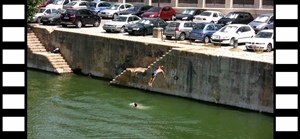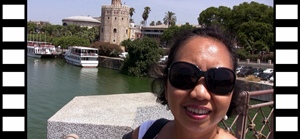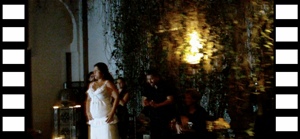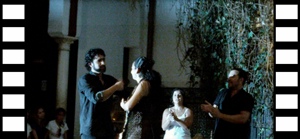We woke up on the morning of our last full day in Seville and resolved to spend it exploring our host city a
little more thoroughly. After our breakfast from the snack supply off the hotel courtyard, we struck out westward
in search of the river that was rumored to pass through the city. We hit water a couple of blocks past the Alcazar
and found ourselves gazing at the fabled Guadalquivir. It’s now a respectable river, having been largely de-silted
in recent years. We walked partway across a nearby bridge (the Puente de San Telmo) to see what there was to
see. We could see the river, obviously, as well as some of the locals enjoying it up close.

Guadalquivir River and Gold Tower

River, Gold Tower and Swimmers

Nella and Gold Tower

River with West Bank and Nella
We could also see the
Gold Tower, a defensive lookout tower originally built in 1220, once linked to the Alcazar. The tower has had several
other uses through the centuries, including a prison, but now houses a maritime museum which we didn't visit.

Gold Tower and Giralda from West Bank

Gold Tower (Torre del Oro)
We also noted a number of padlocks attached to the railing of the bridge with pairs of names or initials on them,
presumably those of romantically-linked couples – apparently the modern equivalent of carving the names in a tree trunk.
Locks on Bridge
We looked at the other side of the river and saw some office buildings and some residences and a restaurant, none
of which looked very interesting, so we returned to the eastern bank and started walking northward. There's a pleasant
shaded walkway that follows the river, apparently another fairly recent innovation.

Pedestrian Walkway, Puente de San Telmo

Nella on East Bank Walkway
We eventually found ourselves across the street from the bullring, so we crossed the Paseo de Cristóbal Colón to get
a closer look at it. The Plaza de Toros de
la Maestranza was built largely in the 18th Century and holds 14,000. Bullfights are normally held on Sunday
evenings between Easter and October. Apparently there are tours and a museum, but we didn't know this at the time and only
looked at the white exterior.

Bullring

Bullring Detail
Outside the ring are bronze statues of famous bullfighters, who evidently are (or have been) like rockstars in Spain.
Bob and Matador Statue (Pepe Luis Vazquez)
We turned away from the river at this point and wandered around pretty aimlessly for awhile, just looking at shops
and things that seemed interesting.

Statue of Woman on Horse

Statue of Flamenco Dancer

Shopping Street (Calle Sierpes)

Chapel of San Jose

Salvador Church

Building, Avenida de la Constitución

Wooden Motorcycle

Picturesque Building
We stumbled across one thing that looked like a gigantic under-construction spacecraft being made from wood. We took
a picture, hoping to sort it out later. Apparently this was part of what is now the Metropol Parasol, a combination
archeological dig / central market / restaurant / observation deck, completed in April of 2011 and billed as the world's
largest wooden structure.
Metropol Parasol Under Construction
We took a break from our wanderings to stop at El Corte Inglés
for lunch. El Corte Inglés seems to be the preeminent department store in Spain. They have stores all over the country,
and they sell pretty much anything you would want to buy. The ones we’ve visited sell so many things they need multiple
more or less co-located buildings to hold everything. Within one such group of buildings it seems there’s one with a
cafeteria on an upper floor (such as the one we ate at) and one with a supermarket in the basement. And somewhere in the
group buildings are selling clothing, appliances, music, movies, furniture, books, etc. etc.

El Corte Inglés

Diego Velazquez Statue (1892) and El Corte Inglés
Deli Counter, El Corte Inglés Supermarket
One last thing we wanted to do in Seville was to see a flamenco show. While flamenco shows can be seen all over
Spain (some would say the best are in Madrid), we wanted to see one in Andalusia, which is the traditional birthplace
of the art. There are a number of tablaos, or flamenco clubs, in Seville, but most cater to tourists and
include overpriced food and drinks. Being non-drinkers and happy to find our own food, we were really only interested
in the performance. Fortunately there are places for people like us, and the one we ended up in was called
the Casa de la Memoria, located just around the
corner from our hotel. The price was more than reasonable, and the performance area was very intimate, consisting of
a patio with two rows of chairs surrounding a small wooden platform.
Dancing Platform
A guitarist and a singer/hand clapper sat in chairs behind the platform, and a succession of dancers took turns on the
platform. Not being a flamenco expert, I couldn't tell you whether they were good or bad (though I would guess not bad),
but everyone seemed intense and disciplined, and Nella and I enjoyed the show immensely. The rest of the audience seemed
to enjoy it as well, and the performers seemed appreciative. Photography was not allowed during the bulk of the performance
because it was distracting, but the last five minutes were reserved for some less intense dancing, and we were allowed to
take pictures for this interval. But it was pretty dark, and they didn't come out that well. Anyway, here's some of what
we got:

Flamenco Performers

Dance by Lady in White

Dancing Couple

Flamenco Performers

Flamenco Performers

Musicians
After the show we returned to the hotel and packed, as we had a reservation for the next day's high-speed train to
Madrid, and would be bidding farewell to Sevilla.































